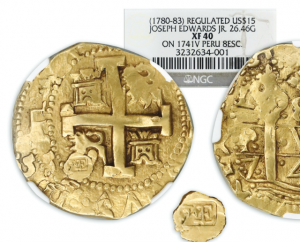Regulated Gold: One of the Rarest Segments of Early U.S. Coin History
Posted on — 1 CommentIn early colonial America, it was common to see foreign coins in everyday commerce. Coins from Brazil, Portugal, Spain, France, and of course England all circulated as legal tender. There were challenges to this hodge podge of coinage in the early days of our nation as each of these foreign coins had a different weight and fineness.
This made commerce challenging as the merchants who traded in these gold coins were ill equipped to test each coin to ensure its purity and weight.
So, in the period before, during and even after the American Revolution, a solution emerged to level the playing field: regulated gold coins. Because different areas of the American colonies had different weight standards for gold coins, metalsmiths played a critical role in regulating the foreign coins in circulation to the appropriate local standards.
How did this work? A metalsmith would assess the coin and regulate its weight to certain standards. They were known as “regulators” and would drill into a coin and add gold in the form of a plug if it was necessary to increase its weight. If it was overweight, the regulator would clip or file its edges. Then, the regulator would stamp the coin with his silversmith mark, identifying who guaranteed the gold content of that particular coin. The marks on the coins were identical to the stamp used by the silversmith on items like silver cups, teaspoons, or even sugar bowls or cream jugs.
The regulators were highly respected members of the community and included prominent people including Ephraim Brasher, William Hollingshead and Thomas Underhill. Ephraim Brasher was a legendary New York metalsmith and jeweler. Brasher was also George Washington’s silversmith and personal friend. Today, numismatics can find his hallmark EB punched onto the coins he regulated.
While not often talked about, regulated gold coins represent an important era in U.S. coin circulation history. Famous collectors and numismatics included regulated coins in their renowned collections, including those of Louis Eliasberg, John J. Ford Jr., and Virgil M. Brand.
In 1795, the U.S. Mint began striking gold coins, which decreased the incentive to use regulated gold coins. At that time, many regulated gold coins were melted down, making these pieces some of the rarest in U.S. numismatic history. However, foreign coins were allowed to be used as legal tender in the United States until 1857, when Congress finally banned their use as legal tender in the Coinage Act of 1857, which officially ended the era of regulated coinage.
Want to read more? Subscribe to the Blanchard Newsletter and get our tales from the vault, our favorite stories from around the world, and the latest tangible assets news delivered to your inbox weekly.
1 thought on “Regulated Gold: One of the Rarest Segments of Early U.S. Coin History”
Comments are closed.









Most interesting, thanks for info on coin history.